Fargo, N.D. -- An
elephant picture hangs on the wall, the mother's trunk curled around
her baby. A Bible verse is printed across the bottom in a smooth
script. As a mother comforts her child, so I will comfort you. Isaiah
66:13. The brown leather sofa and chair sit empty around the opposing
walls, an electric keyboard stands waiting to be played on the fourth
side of the room and a television hides in the corner, next to the
artificial Christmas tree hidden behind the keyboard. The room is
maybe ten by fifteen feet, if we're being generous. The family is
gone.
“When
we do things as a family,” Judith Young said, “we like to go
out.”
She
sits in the West Acres mall by Lighthouse Coffee. Curly, brown hair
hits her just below the shoulder as some gray shows near crest of her
forehead. Her oldest daughter, Adele, 22, sits next to her, each
holding their steaming drinks in blue styrofoam cups. Her son, Evan,
17, sits across from them, mostly silent but gently offering
responses to their direct questions. He draws in a sketchbook—working
on a warrior at first until his sister says “draw me some
broccoli,” and he works on the three-inch-by-three-inch sketch for
45 minutes.
This
single mother of three has lived in public housing for nearly eight
years, and it has allowed her to care for her children's special
needs without sending them into foster care. She has used the system
so her kids can escape it, she said.
 |
| Amber, Judith and Evan after a production of "Les Miserables" at West Fargo High School. |
Her
two youngest kids, Amber, 14, and Evan, are still in high school, and
Adele is preparing to graduate from Concordia College on May 6. Adele
will become the first person in her family to obtain a four-year
degree, and she will be the first child to follow mom's rule that all
of her children must attend college immediately after high school and
obtain degrees in four years. She made that rule because of her own
struggles with career and finances.
“If
you have a college degree, that's something that can never be taken
away from you,” she said. “Not getting that degree, especially
when [my] kids are so intelligent, and with our limited means, not
having it in your tool box is just not OK.”
After
high school graduation, Judith's dad died, and she moved to Grand
Forks to be with family. She struggled in college because of his
death and ended up dropping out. She completed a two-year degree and
had her first child all within a few years of leaving high school.
And yet, she dreamed she would find a husband to raise her daughter.
“I
thought I would be able to do 'middle-class' for Adele,” she said.
“I really thought that would happen.”
Adele
would never need to know the difference, Judith thought. When Adele
was one year old, Judith met Jeff. They were married four years
later.
Adele
had always been a unique and irritable child, but as she was the
oldest, Judith had no point of reference. She assumed Adele's actions
were normal. Adele wouldn't learn until her senior year of college
that she was allergic to nearly all meat proteins, but she knew at an
early age that meat made her feel sick. One daycare provider required
the children to eat all of their food, so Adele pocketed it in her
cheeks. At the end of the day, Judith would bring her home to find
meat in her mouth from lunch.
A
few years after Evan and Amber were born, and the divorce finalized,
Judith got her dream job at the as a surgical assistant and returned
to Fargo. But what seemed to be a dream job turned out not to have
hours conducive for a woman to care for three kids. Judith's mother
had just died two weeks prior to their move, in the same hospital
where Judith would be working, and transplanting kids, ages 3, 5 and
10, was a complicated issue.
“I
was as much of a mess as an eighth grader could be,” Adele said.
Combined
with puberty and anxiety issues, Adele's lack of comfort in social
settings manifested itself in “not so sociable ways,” she said.
Her school in Grand Forks valued individualized education, she said,
but Fargo was different. It wasn't as much of a priority, she said,
and anxiety about doing the new type of homework resulted in it not
getting done.
One
day, a math teacher who habitually ignored Adele's individualized
education program made fun of her in front of the class for not
completing her homework. That's when Adele threw a desk at the
teacher.
“[Adele's]
favorite game in school was 'how much can I piss these people off so
they tell me to leave?'” Judith said.
“It
was a good strategy,” Adele said, shrugging her shoulders.
When
Adele received medication, she slept for three days, Judith said. She
woke up a whole new person. She no longer crouched or hunched over
into herself. Her voice was different.
“There's
no other way to say it,” Judith said, “but it's like in the Bible
when a demon is cast out.”
 |
| Judith and Adele |
As
Adele began to recover, however, Judith began to see some of Adele's
mysterious behaviors in Evan, and Amber's physical health continued
to be poor. Amber had had the stomach flu and chicken pox within her
first few months of life, and she always had any sickness for three
times as long as the rest of the family, Judith said.
These
growing health problems plus the nearly $30,000 Judith spent every
year on child care eventually required her to pull Evan and
homeschool him for the year he would have had Adele's
non-IEP-believing math teacher. Not to mention Judith's awareness of
the risks for unwatched teenagers in their neighborhood.
The
people who live in their public housing community are genuinely nice,
hard-working people, Judith said. Rent is proportional to income, but
getting a raise at work is still worthwhile since rent only increases
by a fraction of that raise, she said. Parents work, but pre-teens
and teenagers often go unsupervised. They can't be in child care, and
they get bored. That's why she gets her kids away from home: not
because the once-innocent faces have turned dangerous, but because
kids without a guiding hand more easily find trouble. They drop out
of high school. They lead difficult lives by all standards. So Judith
has used the system for her kids to be free of it.
“My
real job is being a parent,” she said. “I've done what it takes
to get through.”
She
credits her children's success to scholarships to Trollwood
Performing Arts School, financial and emotional support at church,
social services in schools and through the government and Concordia's
support of Adele. Public housing helped them pay rent. Food stamps
helped buy food. Trollwood gave Adele an outlet. Every step of the
way, they've needed everything they've had. These three kids would
not be graduating from college or consistently lettering in
academics. Judith believes they would not even be alive.
“We
have pieced together a life,” she said, “and we're piecing
together a future as a family.”
Judith
now works at Bank of the West, where she has worked since May 2011.
If she can move into a full-time position, she plans to utilize the
education benefits to return to school and finish a four-year degree
like she requires all of her kids to do. After years of counseling
and rebuilding their family, they are finally in a better place.
Judith is finally able to pay her bills.
Adele's
recent allergy testing revealed she is allergic or sensitive to
wheat, eggs, corn, dairy and most meat proteins as well most
environmental allergens, such as trees and mosses. She also has a
high-functioning case of Autism Spectrum Disorder, but on May 6,
2012, she will receive the same bachelor's degree as any other
English writing major at Concordia, and her family will be there to
see her walk.
Judith
pulls out her EBT food stamp card. The outline of North Dakota sits
in the upper left corner, filled with pink wild prairie roses, the
state flower. Using the card was the biggest source of embarrassment
while she needed the aid, she said. But now, she keeps it in her
purse as a reminder of the social services that saved her family.
“The
whole world can end, and we'll figure it out,” Adele said. “I'm
seriously not afraid of a zombie apocalypse.”


